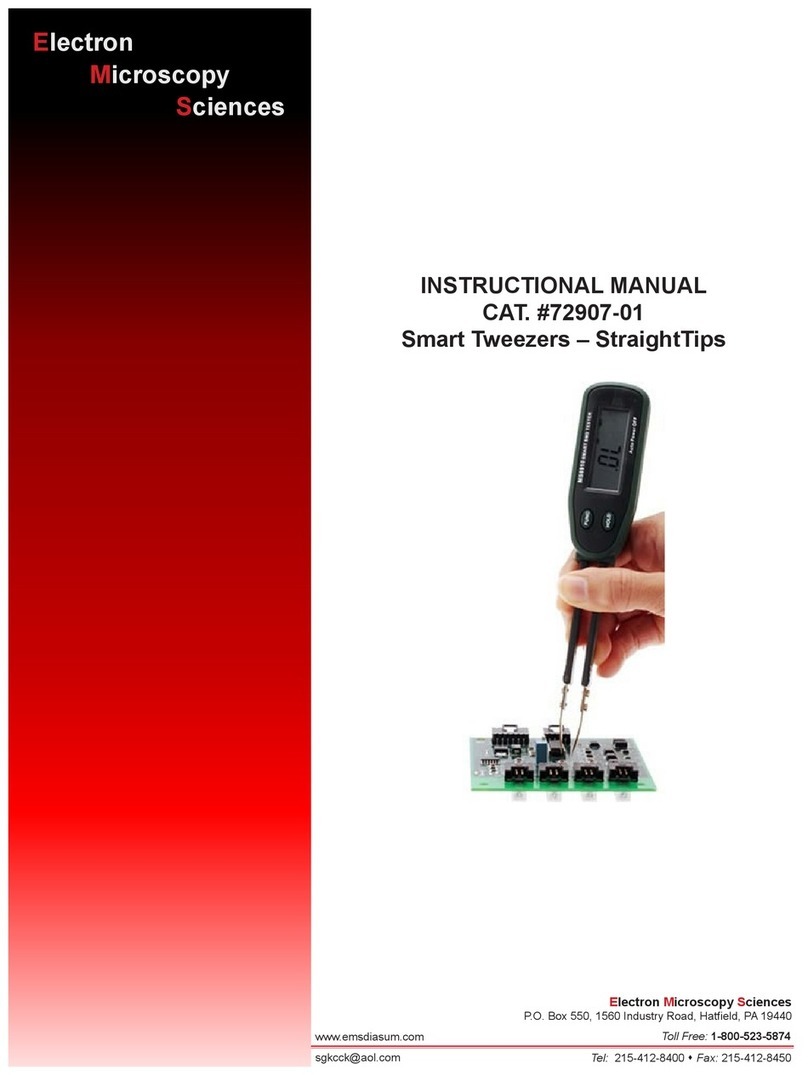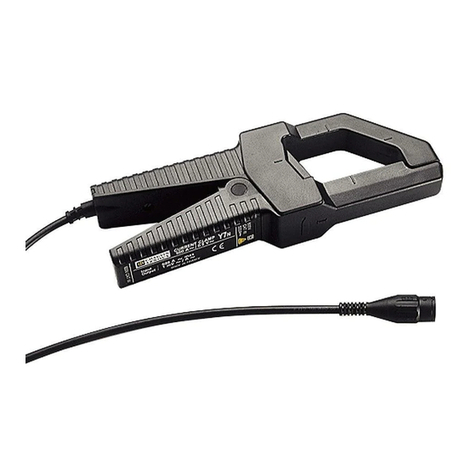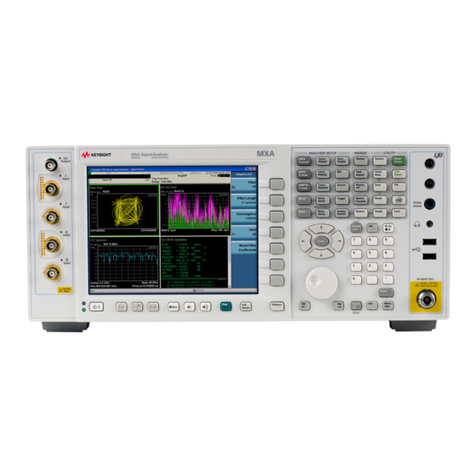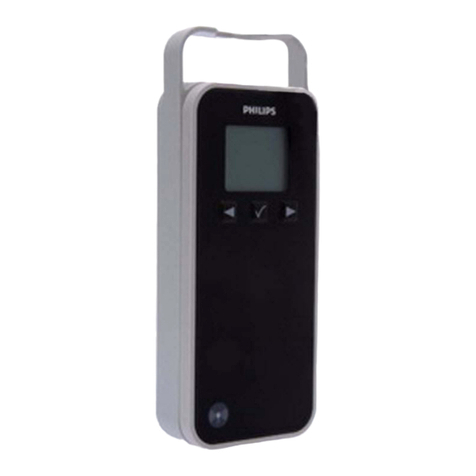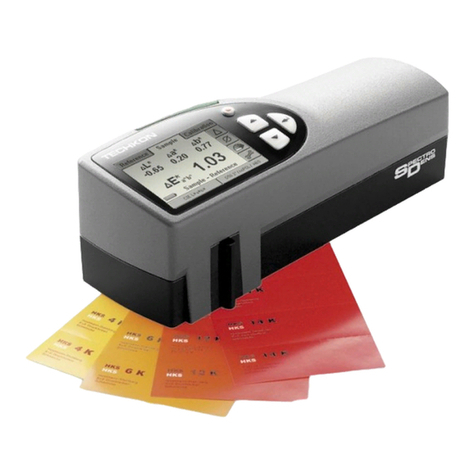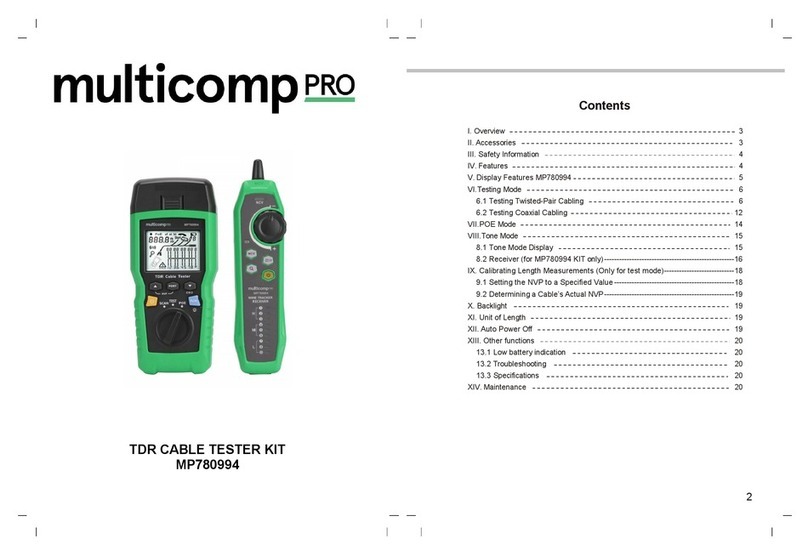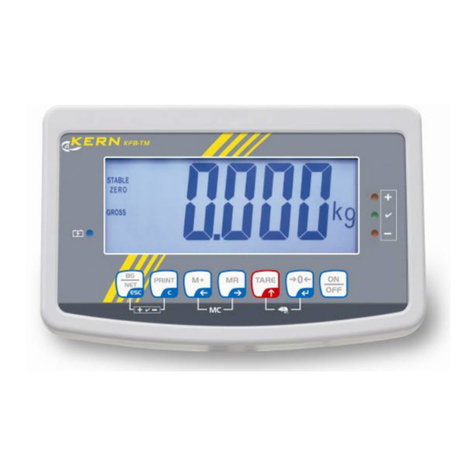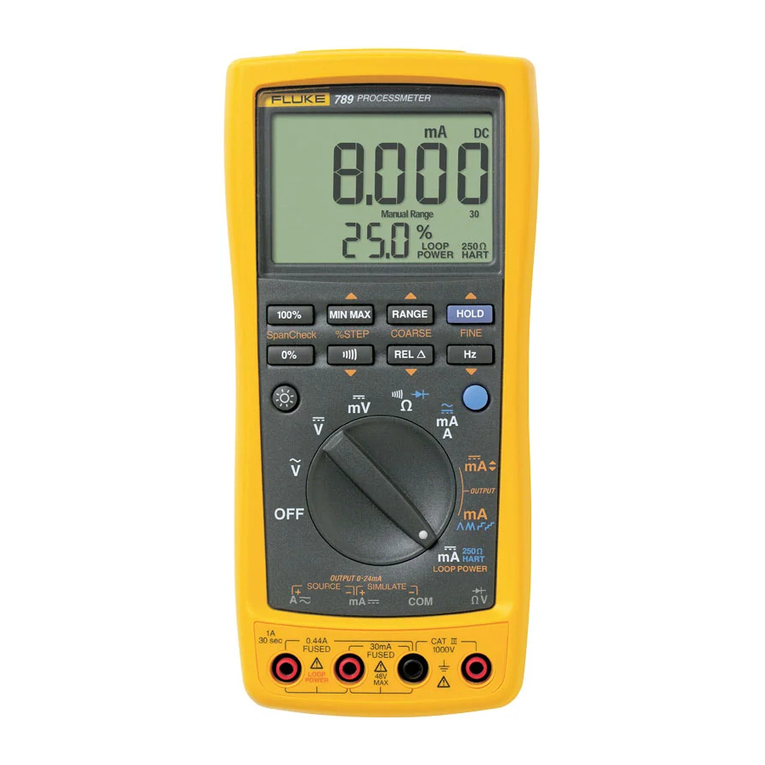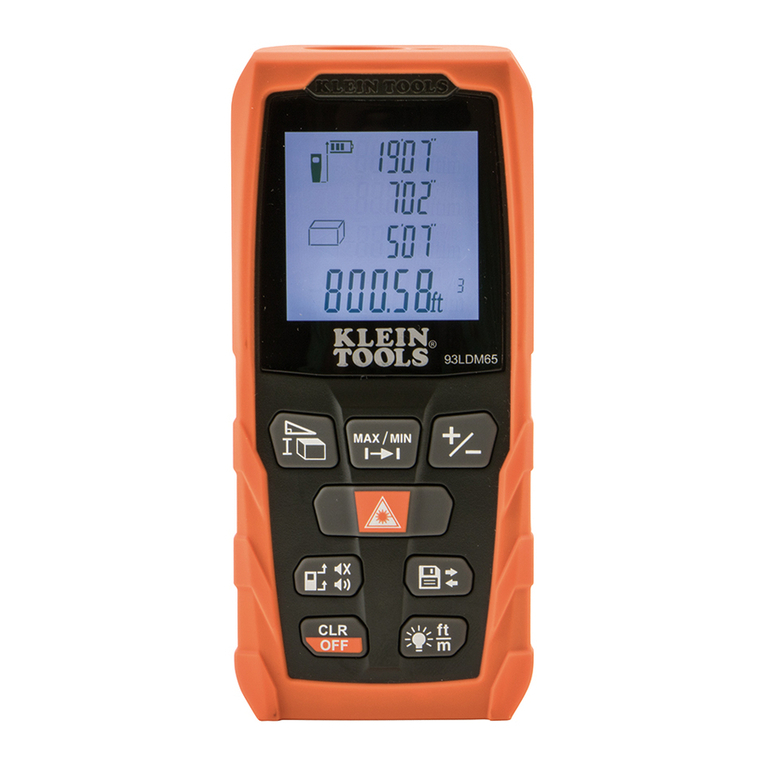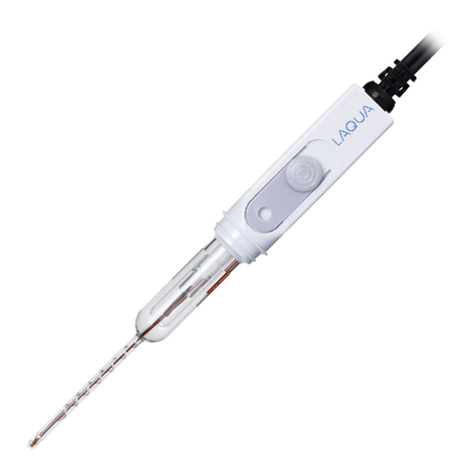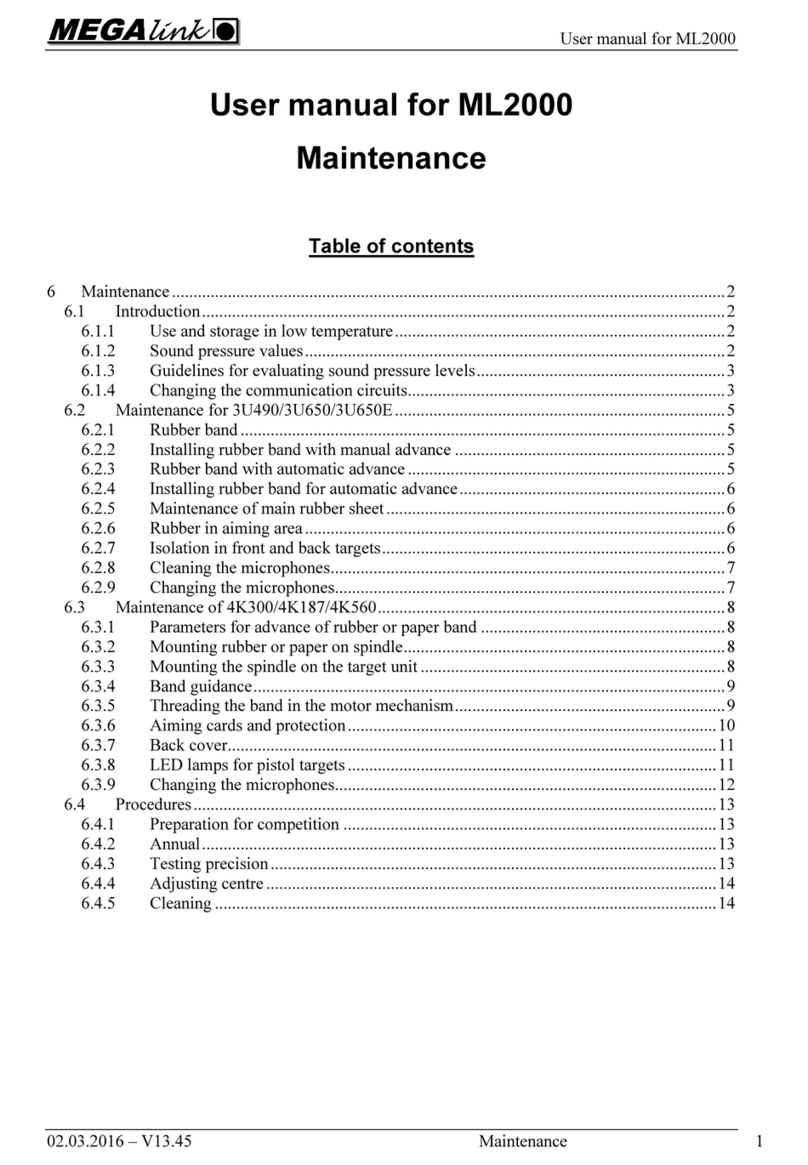Electron Microscopy Sciences 72088-01 User manual

INSTRUCTIONAL MANUAL
CAT. #72088-01, 72088-02
Advanced pH Meter &
Advanced pH Meter Kit
Electron
Microscopy
Sciences
www.emsdiasum.com
Toll Free: 1-800-523-5874
Electron Microscopy Sciences
P.O. Box 550 s1560 Industry Road s Hateld PA 19440
Tel: 215-412-8400 sFax: 215-412-8450

1
www.emsdiasum.com
P.O. Box 550 s1560 Industry Road s Hateld PA 19440
Toll Free: 1-800-523-5874Electron Microscopy Sciences
Tel: 215-412-8400 sFax: 215-412-8450
LCD Display
• LCD display indicates pH, mV, ORP
(mV).
• pH, mV indicates the unit of measure
displayed.
• The two digits to the right of °C °F on
the display indicate the total number
of records that contain stored data.
• Real time 88:88:88 is real-time Y-M-D
or H:M:S.
• °C/°F are temperature units of measure.
HLD
ATC
MAX
MIN
READY
CAL
%
mV
pH
Press to switch mode.
Press to increase setting value.
REC
Press to turn meter on/off. Press and hold
for more than 1 second to enter SET mode.
Press to freeze reading. Press again to re-
lease. Press for more than 1 second to switch
between NORMAL and RECALL mode.
Switch between NORMAL and CALIBRA-
TION mode Press to enter manual tem-
perature setting. In calibration, setting or
recall mode, press to return to normal.
Press to conrm calibration/parameter
setting. Press to view the min/max of the
memory in recall mode.
Press to save current reading.
Press to decrease the setting value.
• HLD Holds the current reading on the dis-
play.
• ATC means the meter is in automatic tem-
perature compensation mode.
• MAX, MIN indicate maximum or minimum
memory value.
• READY indicates the reading is stable.
• CAL indicates the meter is in calibration
mode.
• REC indicates the meter is in recall mode.
{
{
Introduction
Benchtop level analysis in the eld! Reads either pH (in 0.01 resolution) or mV in large digits, with time, date, and tem-
perature (in °C or °F) shown simultaneously on the lower display. Also indicates stable reading, low battery and displays
calibration data. Scroll 99 data points with time stamps and min/max readings directly on the backlit LCD.
Features:
• Multi-display LCD screen
• 5 points pH calibration
• N.I.S.T. buffer recognition
• Maximum and minimum
• Hold function
• Backlight for dark environment operation
• Easy to view probe calibration data
• “Ready” icon on LCD display indicates stability for reading
• USB connection for online logging and uploading 99 mem-
ories to PC for analysis
• Automatic or manual temperature compensation
• External power adapter (optional) for long use testing
• Auto power off to save battery

2
www.emsdiasum.com
P.O. Box 550 s1560 Industry Road s Hateld PA 19440
Toll Free: 1-800-523-5874Electron Microscopy Sciences
Tel: 215-412-8400 sFax: 215-412-8450
Setup Mode
NOTES: R To enter Setup Mode, press SET for about 2-3 seconds while the meter is in Normal Mode.
R To exit Setup Mode without saving, press ESC until the Normal Mode appears.
R If the meter is in Setup Mode, press ESC twice to exit.
1. Connect USB cable to the right side of the meter and connect the other end of the cable
with the D-sub connector to the computer’s serial port. Run the software associated with
this feature.
2. Press SET for 2 seconds to enter setup.
3. The “TR” icon appears on the middle of the LCD display and P1.0 displays under the “TR” icon.
4. Press MN/MX/AV. The “OUT” icon ashes on the upper display and P1.1 displays under
the “OUT” icon. This indicates that the memories are transferring. After transmission, the
LCD will return to P1.0.
NOTE: The meter can store up to 99 records for each parameter. To transmit data for a differ-
ent parameter, press ▲ to select desired parameter before entering setup.
P 1.0 Memory Transmission
P 2.0 Clear Memory
P 3.0 Electrode (pH probe)
P 4.0 Buffer Solution (pH)
The advanced Setup Mode allows you to customize the following meter preferences and defaults:
P 5.0 Ready Function
P 6.0 Temperature Units
P 7.0 Real Time Clock
P 8.0 Reset
P 1.0 Memory Transmission – transfers stored data from the meter to the computer
Press MODE to select the parameter you want cleared before entering Setup Mode.
1. Press SET for 2 seconds to enter setup.
2. Press ▲ to select memory clear function.
3. The “CLR” icon appears on the middle display and P2.0 illuminates in the lower display.
4. Press MN/MX/AV to enter P2.1.
5. The default “NO” icon ashes on the middle display and P2.1 appears in the lower dis-
play.
6. Press ▲ to change the status from “NO” to “YES” and then press MN/MX/AV again to
conrm clearing of all memory. The LCD display will return to P2.0 when memories are
deleted.
P 2.0 Clear Memory
The memory clear program is designed to clear 99 memories at one
time. Proceed cautiously, as this operation cannot be reversed.

3
www.emsdiasum.com
P.O. Box 550 s1560 Industry Road s Hateld PA 19440
Toll Free: 1-800-523-5874Electron Microscopy Sciences
Tel: 215-412-8400 sFax: 215-412-8450
Press MODE to select the parameter you want cleared before entering Setup Mode.
1. Press MODE to select probe type as pH.
2. Press SET for 2 seconds to enter setup.
3. Press ▲ until the icon “ELE” appears in the middle display and
P3.0 appears in the lower display.
4. Press MN/MX/AV to enter P3.1, the LCD displays one of four
available slope values; P3.1, P3.2, P3.3, P3.4. If the value is less
than 75% or more than 115%, change the probe immediately.
5. Press MN/MX/AV to enter P3.2, P3.3, and P3.4.
NOTE: The solution range denition differs between NIST and Cus-
tom buffers.
6. Press MN/MX/AV to enter P3.5 and view the offset value. The offset value is the mV value of pH 7 and the default
offset value is 0.0. The offset value will be different after calibration. If the value is outside the range of ± 60 mV,
replace the probe.
P3.0 View Slope & Offset
P4.0 pH Calibration Buffer
This meter allows the selection of two different types of pH buffers: NIST or CUSTOM. Selection of the proper buffer type
more accurately calibrates the probe to specic requirements.
R NIST buffer has ve settings:
pH 1.68, 4.01, 6.86, 9.18, 12.45
R CUSTOM buffer has ve ranges:
pH 1.00-3.00, 3.50-5.50, 6.00-8.00, 8.50-10.50, 11.50-13.50
Select Buffer
1. Press SET for 2 seconds to enter setup.
2. Press ▲ to select pH buffer. “BUF” will appear on the middle of the LCD and P4.0 will
appear on the lower portion.
3. Press MN/MX/AV to enter P4.1. The default “NIS” (NIST) will ash on the LCD and P4.1
will appear on the lower portion of the display. If you use N.I.S.T. buffers, press MN/MX/
AV to conrm and the meter returns to P4.0.
4. If your requirement is not for NIST buffers, press ▲ to change the status to CUSTOM
buffer.
5. Press MN/MX/AV to conrm and the meter will return to P4.0.
Solution Range
Buffer P3.1 P3.2 P3.3 P3.4
NIST 0.00 ~ 4.01 4.01~ 6.86 6.86~9.18 9.18~14.00
Custom 0.00 ~ 4.50 4.50~7.00 7.00~9.50 9.50~14.00
Setup Mode, continued

4
www.emsdiasum.com
P.O. Box 550 s1560 Industry Road s Hateld PA 19440
Toll Free: 1-800-523-5874Electron Microscopy Sciences
Tel: 215-412-8400 sFax: 215-412-8450
P5.0 Ready Icon – enables/disables the “READY” icon, indicating that the measured reading is stable.
1. Press SET for 2 seconds to enter setup.
2. Press ▲ to select “READY” on the display.
3. Press MN/MX/AV to enter P5.1. “YES” will ash on the LCD display and P5.1 will appear on the lower display.
4. Press ▲ to switch between YES or NO.
5. Press MN/MX/AV to conrm.
6. Press ESC to return to Normal Mode.
P6.0 Temperature Units – select either Celsius or Fahrenheit temperature scale
1. Press SET for 2 seconds to enter setup.
2. Press ▲ to select “U” on the upper display. P6.0 is displayed in the lower portion of display.
3. Press MN/MX/AV to enter P6.1. The last selected unit “C” or “F” will appear on the LCD.
4. Press ▲ to select either display.
5. Press MN/MX/AV to save the selection.
6. Press ESC to return to Normal Mode.
P7.0 Real Time Clock Setting – adjusts the meter’s internal clock
NOTE: An internal battery powers the real time clock independent of the power source running the meter.
1. Press SET for 2 seconds to enter setup.
2. Press ▲ to select “RTC” on the LCD display. P7.0 appears on the bottom of the display.
3. Press MN/MX/AV to enter P7.1. The year ashes in the lower right corner of the LCD display. (The year is the last two
digits only; for example, 1999 would be 99).
Symbol: Y-M-D H:M:S
Denition: Yr.-Mo.-Day Hr.-Min.-Sec.
Range: 99-12-31 23-59-59
4. Press MN/MX/AV to step through the following “P’s.” All are two digits.
P7.1 = Year P7.2 = Month P7.3 = Day
P7.4 = Hour P7.5 = Minute P7.6 = Seconds
5. Press ▲ and ▼ to adjust values up or down, respectively.
6. Press ESC to return to P7.0 and Normal Mode.
Setup Mode, continued

5
www.emsdiasum.com
P.O. Box 550 s1560 Industry Road s Hateld PA 19440
Toll Free: 1-800-523-5874Electron Microscopy Sciences
Tel: 215-412-8400 sFax: 215-412-8450
P8.0 Reset – resets the meter to factory default setting
NOTE: Memory locations are not reset after this procedure.
1. Press SET for 2 seconds to enter setup.
2. Press ▲ to select the reset section of the meter.
3. “rSt” will appear on the LCD and P8.0 will appear directly below.
4. Press MN/MX/AV to enter P8.1.
5. Press ▲ to switch between “YES” or “NO.”
6. Press MN/MX/AV to conrm.
7. Press ESC to return to Normal Mode.
Probe Calibration
• Calibrate before each use, if the readings seem erratic, and whenever the batteries are replaced.
• Two-point calibration produces the highest accuracy.
• When using single-point calibration, the buffer temperature must remain stable and the buffer value needs to be
close to the sample that will be measured.
1. Press POWER to turn the meter on and press MODE to select “pH” mode. “pH” appears on the LCD.
2. Select the calibration buffer type: NIST or CUSTOM
Note: pH 4 may be calibrated using either the NIST (recommended option) or CUSTOM buffer. pH 7 and pH 10 require
the CUSTOM buffer. (See SETUP MODE on page 14.)
3. Rinse the probe in de-ionized water or rinse solution. DO NOT wipe the pH probe dry. Wiping the probe may cause
static and cause calibration and measurement instability.
4. Select the pH buffer and pour enough solution to totally immerse the probe tip into a clean container.
5. Dip the probe into the container, immersing the probe tip.
6. Stir the probe gently to create a uniform sample.
7. Press CAL to enter calibration mode. “CA” will ash on the LCD.
8. The pH value appears on the main display and 2.00 appears on the secondary display (CUSTOM) or 4.00 appears
on the secondary display (N.I.S.T.).
9. When the measured pH value is stable and the Ready function is enabled (Refer to P5.0 READY ICON page 15).
“READY” will appear on the left side of the LCD.
Note: If the pH value continues to display different values, check the buffer or probe. (Refer to TROUBLESHOOTING
page 32).
NOTE: For highest accuracy:
Directions
Setup Mode, continued

6
www.emsdiasum.com
P.O. Box 550 s1560 Industry Road s Hateld PA 19440
Toll Free: 1-800-523-5874Electron Microscopy Sciences
Tel: 215-412-8400 sFax: 215-412-8450
Measurement Procedures
NOTE: If using N.I.S.T. buffer: Skip to step 10.
NOTE: If using CUSTOM buffer: Follow instructions for your selected buffer solution:
pH 4
Press HLD/REC. 4.50 appears on the secondary display. Use ▲ or ▼ to adjust to 4.00.
pH 7
Press HLD/REC. 4.50 appears on the secondary display.
Press HLD/REC again. If the secondary value does not default to 7.00, use ▲ or ▼ to adjust to 7.00.
pH 10
Press HLD/REC. 4.50 appears on the secondary display.
Press HLD/REC again. 7.00 appears on the secondary display.
Press HLD/REC again. 9.50 appears on the secondary display. Use ▲ or ▼ to adjust to 10.00.
10. Press MN/MX/AV to conrm. Press ESC to save and return to Normal Mode.
11. Change the buffer solution and repeat previous steps to achieve multiple point calibration.
NOTE: Clean the probe in between each buffer.
Probe Calibration - Directions, continued
NOTE:
• The meter is powered by 4 AAA batteries. Install batteries or connect an AC adapter to the power jack on the side of the meter.
• Connect a sensor probe to the BNC connector on top of the meter.
• For the pH probe with temperature sensor, also connect the plug into the jack to the right of the BNC connector.
• Connect the USB cable to the meter and computer to upload measurements for computer analysis.
Probe Measurement Parameters
Probe pH mV
ORP Probe N/A Yes
pH Probe Yes Yes
IMPORTANT: The temperature of the measured liquid must be stable.
pH Measurement
Readings with automatic or manual temperature compensation can be taken with this meter.
Automatic temperature compensation: Temperature sensor needs to be plugged into the meter.
Manual temperature compensation: default setting is 25°C. NOTE: It is also possible to manually adjust the tempera-
ture to match working conditions, as measured by a separate thermometer.
Directions for taking measurement
1. Remove the pH probe soaker bottle by rotating the bottle and cap and slide the bottle and cap off the probe. Rinse the
probe tip with de-ionized or distilled water before use. If the probe tip is dehydrated, soak it for 30 minutes in a KCl solution.
DO NOT wipe the pH probe dry. Wiping the probe may cause static and cause calibration and measurement instability.
2. Press POWER to turn on. ATC appears to indicate that the automatic temperature compensation probe is connected
and working properly.
3. Immerse the probe tip (glass bulb) completely into the sample.
4. Stir the probe gently to create a uniform sample.
5. Wait until the reading has stabilized. If selected in setup, “READY” illuminates to indi-
cate a stable reading.

7
www.emsdiasum.com
P.O. Box 550 s1560 Industry Road s Hateld PA 19440
Toll Free: 1-800-523-5874Electron Microscopy Sciences
Tel: 215-412-8400 sFax: 215-412-8450
Measurement Procedures, continued
NOTE: mV measurement range is from -499 mV to +499 mV with a pH probe.
1. Remove the pH probe soaker bottle by rotating the bottle and cap and slide the bottle and cap off the probe. Rinse the
probe tip with de-ionized or distilled water before use. If the probe tip is dehydrated, soak it for 30 minutes in a KCl solution.
DO NOT wipe the pH probe dry. Wiping the probe may cause static and cause calibration and measurement instability.
2. Press POWER to turn on. Press MODE to select mV mode.
3. Immerse the probe tip (glass bulb) completely into the sample.
4. Stir the probe gently to create a uniform sample.
5. Wait until the reading has stabilized. If selected in setup, “READY” illuminates to
indicate a stable reading.
6. To switch between mV and pH, press MODE.
NOTE: ORP (Oxidation Reduction Potential) measurement range is-1999 mV to +1999 mV. Use an ORP probe for mea-
surement:
1. Remove the pH probe soaker bottle by rotating the bottle and cap and slide the bottle and cap off the probe. Rinse the
probe tip with de-ionized or distilled water before use. If the probe tip is dehydrated, soak it for 30 minutes in a KCl solution.
DO NOT wipe the pH probe dry. Wiping the probe may cause static and cause calibration and measurement instability.
2. Press POWER to turn on. Press MODE to select mV measurement.
3. Immerse the probe tip (glass bulb) completely into the sample.
4. Stir the probe gently to create a uniform sample.
5. Wait until the reading has stabilized. If selected in setup, “READY” illuminates to
indicate a stable reading.
NOTE: There is no need to take temperature compensation into consideration when
using an ORP probe to measure.
Temperature Compensation
Automatic with pH probe (ATC):
Plug the temperature sensor connector into the jack on top of the meter next to the larger BNC connector.
Manual with pH probe (MTC):
1. To set the temperature, press MN/MX/AV for more than 2 seconds, “CA” will ash on the LCD Display.
2. Press the ▲ or ▼ to change the temperature value and then press MN/MX/AV to save and return to Normal Mode.
Directions for taking mV measurement (± 499mV)
Directions for taking ORP (mV) Measurement (± 1999mV)

8
www.emsdiasum.com
P.O. Box 550 s1560 Industry Road s Hateld PA 19440
Toll Free: 1-800-523-5874Electron Microscopy Sciences
Tel: 215-412-8400 sFax: 215-412-8450
Hold Function
This function allows you to freeze the current reading on the display in Normal Mode.
1. Press HLD in Normal Mode. “HLD” appears on the display.
2. Press HLD and the meter returns to Normal Mode.
Record Memory and Recall Memory
Record Memory
The meter can store up to 99 records each of pH, mV, and ORP (mV) readings.
1. In any measurement or Hold Mode, press MEM to save the data.
2. The memory number and measured value will ash and then return to Normal Mode.
NOTE: Further data can not be saved once the memory is full. See Clear Memory on page 11 to create additional space.
Recall Memory
This function recalls readings stored in the memory.
1. \Press REC for more than 2 seconds to enter Recall Mode. “REC” will ash on the
LCD display.
2. Press ▲ to select next memory content. Press ▼ to select previous memory.
3. To exit memory recall, press REC for more than 2 seconds.
Recall Maximum & Minimum
This function reviews a maximum and minimum value for all the data points stored in memory.
1. Press REC for 2 seconds to enter Recall Mode. “REC” will ash on the LCD.
2. Press MN/MX/AV to view the minimum value of the memory.
3. Press MN/MX/AV again to view the maximum value.
4. To exit memory recall, press REC for more than 2 seconds.
Backlight
• Press any button to activate the backlight function.
• The backlight turns off automatically after 10 seconds of inactivity.
Auto Power Off
NOTE: The auto power off function will be disabled while in calibration mode.
• The meter turns off automatically after 20 minutes of inactivity.
• To override the function, hold down POWER and HLD simultaneously for 2
seconds when turning the meter on until “n” appears.

9
www.emsdiasum.com
P.O. Box 550 s1560 Industry Road s Hateld PA 19440
Toll Free: 1-800-523-5874Electron Microscopy Sciences
Tel: 215-412-8400 sFax: 215-412-8450
Maintenance
pH Probe
NOTE: pH probe must be kept wet when the meter is not in use. The probe is well protected
by a plastic bottle containing solution.
To Use or Store Probe
• Rotate the bottle to remove from the probe. Pull down the cover and remove it from
the probe.
• After use, put cover back on the probe and plug the probe into the bottle. Rotate the
bottle to t into the cover tightly.
Preventative Maintainance
• Never use distilled or de-ionized water for storage.
• Never touch or rub the glass bulb tip.
• Always keep the pH glass bulb wet by using the plastic bottle to protect and store
the probe. It can also be stored in a KCl solution.
• Always rinse pH probe in de-ionized water before using.
Probe Testing
1. Connect the ORP probe to the meter via the BNC connector.
2. Put the probe in a buffer solution of pH 7.00 with saturated quinhydrone.
3. Stir; mV reading (E1) should be 86 ±15mV.
4. Rinse the probe with distilled water between each use.
NOTE: Keep the ORP probe wet. If not in use for long periods, rinse and store in the soaker bottle lled with the saturated
KCL solution.
ORP Probe Cleaning
Slow response time and/or inaccurate reading can result from a contaminated sensing element. It is recommended to
clean ORP after every use. Contamination can come from either mineral matter or oil/grease. Follow the protocol below
for decontamination.
Mineral Contamination – put the sensing element in a HCl solution 0.1 N for 10 minutes. Rinse in distilled water.
Oil/Grease Contamination – clean with a mild detergent, then rinse with distilled water.
NOTE: Upon completion of either cleaning method, immerse the probe in a saturated buffer solution with pH 4.01 for 15
minutes and rinse with distilled water.
Probe Performance
The ORP probe sensing element is made of a high purity metal. Clean the element when slow response time and inac-
curate readings occur which may be caused by an oxidation reduction coating that formed on the surface of the sensing
element after it has been soaked in a solution for a long time period. Clean the element to.
A slow response time and inaccurate readings may also occur when measuring solutions with a low concentration of
oxidation reduction matter and slow ion exchange rate. It may take 8-24 hours to obtain an accurate reading under these
conditions.

10
www.emsdiasum.com
P.O. Box 550 s1560 Industry Road s Hateld PA 19440
Toll Free: 1-800-523-5874Electron Microscopy Sciences
Tel: 215-412-8400 sFax: 215-412-8450
Issue Solution
Meter does not turn on 1. Press POWER for more than 2 seconds.
2. Check connections of the power adapter or batteries.
Unstable readings
1. Stir the solution to make a uniform sample and make sure the sensor is completely
immersed in the solution. NOTE: The measurement must be done while probe is in
the container/solution.
2. RF emissions from unknown source may disrupt readings, so move to new location
for measurement.
Readings not changing
1. Check to see if meter is in “HOLD” mode.
2. Release “HOLD” function.
3. Check to see if meter is in “MTC,” if so, input temperature value.
Slow response 1. Clean and re-calibrate the probe.
2. Replace with a new probe.
Wrong real time NOTE: Incorrect real time display will not affect the measurements.
1. Internal batteries (separate from internal batteries that power the meter) need replacing.
Troubleshooting
Error Codes
Error
code Description
E02 Reading is under the lower limit
E03 Reading is over the upper limit
E04 Preceded by another error
E12 Factory calibration data error; Reset meter
E13 Slope or Offset value of pH probe is out of range
E31 Measuring circuit failure; Restart meter
E32 Memory Integrated Circuit failure

11
www.emsdiasum.com
P.O. Box 550 s1560 Industry Road s Hateld PA 19440
Toll Free: 1-800-523-5874Electron Microscopy Sciences
Tel: 215-412-8400 sFax: 215-412-8450
PC Connections
The meter can interface with a personal computer to capture online or stored data.
Directions
1. Plug the USB cable into the cable jack on the side of the meter.
2. Plug D-sub 9 pin type connector into a computer Serial COM port. NOTE: COM ports 1-8 can be used.
3. Insert CD-Rom in computer and follow the procedure in the operation manual located on the CD.
Protocol Information
Protocol Information
USB protocol settings 9600 bps, 8 data bits, no parity. (Transmits ASCII code every second.)
Normal Data
pxx.xxpH: mxx.xxmV:Txxx.xC(F)@ 2007-04-18
18:48:48LRCCRLF
Errors
ExxNul: ExxNul: ExxNul @ 2007-04-18
18:48:48LRCCRLF
Description $pH:mV:TpH LRC CRLF
Reading the Values
First value is pH reading in pH
Second value is Voltage reading in mV,
Third value is Temperature of pH probe inC/F
“x” is a numerical value
Format in Memory Transmit pH Mode
Protocol Information
Normal Data
Pxx.xxpH: Txxx.xC(F)#xx@2007-04-18
18:48:48LRCCRLF
Errors
ExxNul: ExxNul: #xx @2007-04-18
18:48:48LRCCRLF
Description $pH: Temp LRCCRLF
Format in Memory Transmit mV Mode
Protocol Information
Normal Data
Mxx.xxmV: Txxx.xC(F) #xx @2007-04-18
18:48:48LRCCRLF
Errors
ExxNul: ExxNul #xx @2007-04-18
18:48:48LRCCRLF
Description $mV:Temp LRC CRLF

12
www.emsdiasum.com
P.O. Box 550 s1560 Industry Road s Hateld PA 19440
Toll Free: 1-800-523-5874Electron Microscopy Sciences
Tel: 215-412-8400 sFax: 215-412-8450
Power Supply
The meter can be powered by a 9V external adapter or by 4 AAA batteries. When using batteries, ensure the batteries are
inserted into the compartment correctly and securely. NOTE: Check polarity before inserting the batteries.
pH/mV Default Preferences (Display “pH” )
Program Preference Default Displayed
P1.0 Memory (Transmitting) No default “tr”
P1.1 Memory Sent by USB No default “out”
P2.0 Memory Clear “no” “CLr”
P2.1 CLR Conrm “no” “no” / “yes”
P3.0 Electrode “ELE”
P3.1-3.4 Slope 100.0% Slope value
P3.5 Offset 0.0 mV Offset value
P4.0 Buffer Solution “buF”
P4.1 Select Buffer “NIST” “nist” / “cust”
P6.0 Ready Function “rdy”
P6.1 Enable or Disable “yes” “no” / “yes”
P7.0 Temp Unit “U”
P7.1 Select C or F “C” “C” or “F”
P8.0 Real Time Clock “rtc”
P8.1-8.6 Setting YMD, HMS “rtc”
P9.0 Reset “no” “rst”
P9.1 Reset Conrm “no” “no” / “yes”
Specications
Parameter Range Resolution Accuracy
pH 0 to 14 0.01 ± 0.02 pH
mV -499 to 499
± 0.1 mV
(-199.9 to 199.9)
otherwise ± 1mV
± 0.2 mV
-199.9 to 199.9
otherwise ± 2 mV
ORP -199.9 to199.9
± 0.1 mV
(-199.9 to 199.9)
otherwise ± 1mV
± 0.2 mV
-199.9 to 199.9
otherwise ± 2 mV
Temp °F 23 to 176ºF 0.1º ± 2 ºF
Temp °C -5 to 80ºC 0.1º ± 1 ºC

13
www.emsdiasum.com
P.O. Box 550 s1560 Industry Road s Hateld PA 19440
Toll Free: 1-800-523-5874Electron Microscopy Sciences
Tel: 215-412-8400 sFax: 215-412-8450
Specications, continued
Operation temperature: 5°C to 40°C
Operation RH%: Up to 95% without condensation
Storage Temperature: -20°C to 60°C
Storage RH%: Up to 95% without condensation
Dimensions: 7" × 2¾" × 1¼" (178 × 70 × 32 mm)
Weight: 6.5 oz (184 g)
Temperature Effect on NIST pH Buffers
0°C 5°C 10°C 15°C 20°C 25°C 30°C 35°C 40°C 45°C 50°C
pH 1.68 1.67 1.67 1.67 1.67 1.68 1.68 1.69 1.69 1.70 1.70 1.70
pH 4.01 4.01 4.01 4.00 4.00 4.00 4.01 4.01 4.02 4.03 4.04 4.06
pH 6.86 6.98 6.95 6.92 6.90 6.88 6.86 6.85 6.84 6.84 6.83 6.83
pH 9.18 9.47 9.38 9.32 9.27 9.22 9.18 9.14 9.10 9.07 9.04 9.01
pH 12.45 13.43 13.21 13.00 12.81 12.63 12.45 12.29 12.13 11.99 11.84 11.70

For any questions or for ordering information,
please contact Customer Service at
1-800-523-5874
Thank you for choosing
Electron Microscopy Sciences!
www.emsdiasum.com
Tel: 215-412-8400 sFax: 215-412-8450
Electron Microscopy Sciences
P.O. Box 550
1560 Industry Road, Hateld, PA 19440
Electron
Microscopy
Sciences
This manual suits for next models
1
Table of contents
Other Electron Microscopy Sciences Measuring Instrument manuals
Popular Measuring Instrument manuals by other brands
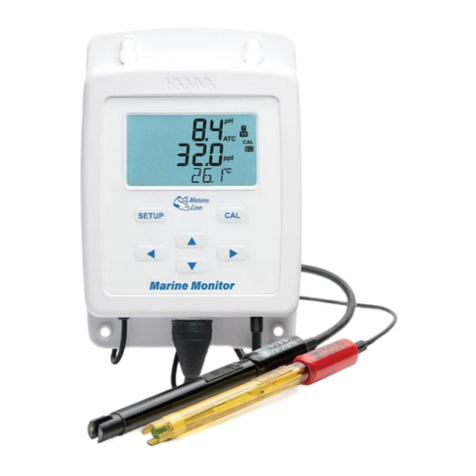
Hanna Instruments
Hanna Instruments HI981520 instruction manual

MICRO-EPSILON
MICRO-EPSILON NLS3181 instruction manual
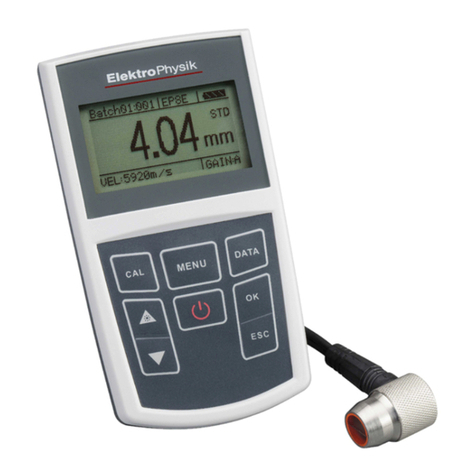
ElektroPhysik
ElektroPhysik MiniTest 440 Technical Reference and Operating Manual
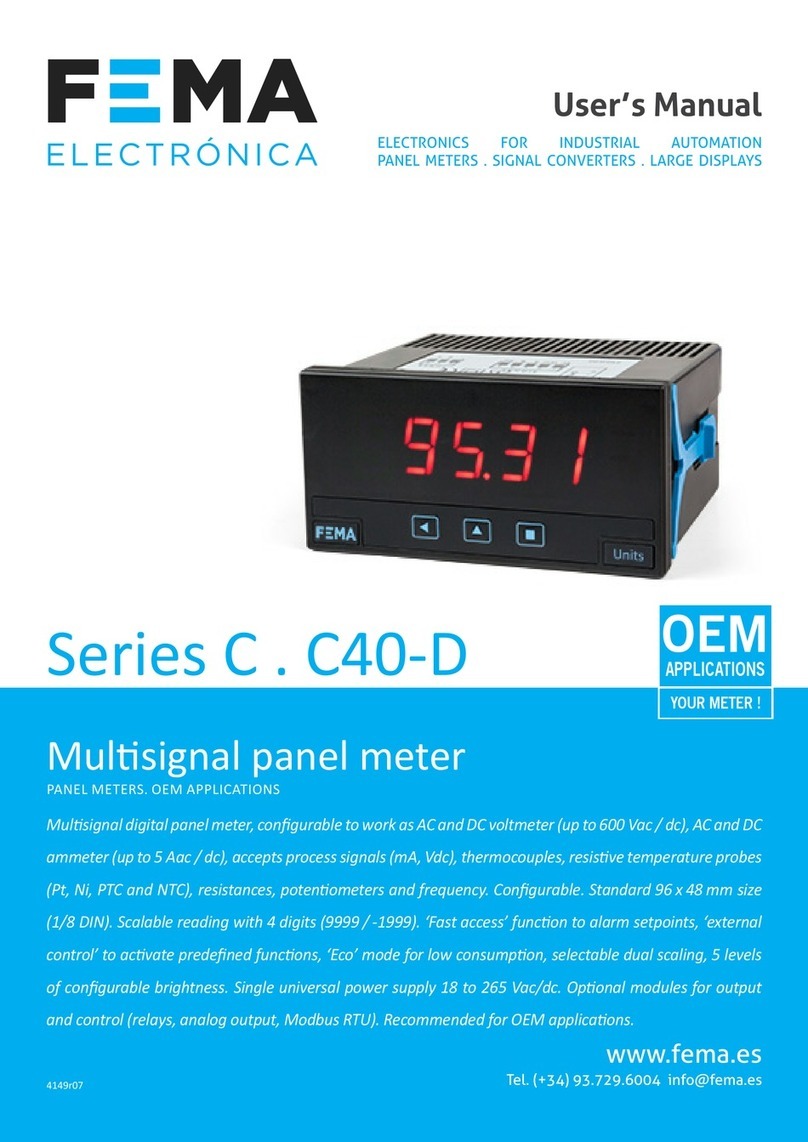
Fema
Fema C Series user manual

Klark Teknik
Klark Teknik Jade One MK II Operating and service information
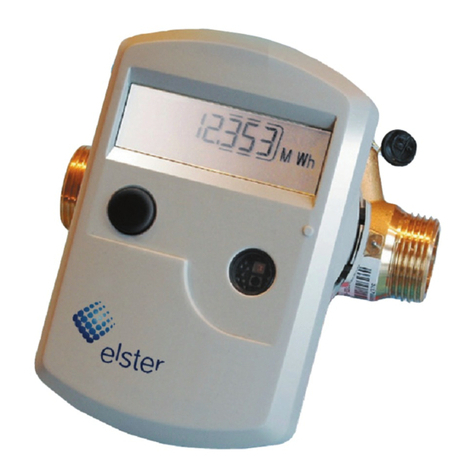
Elster
Elster F90S manual
